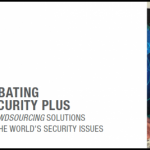The following is an excerpt from the Debating Security Plus 2017 report published by Friends of Europe.
Since Russia’s 2014 actions in Crimea, the term “hybrid warfare” has become a new buzzword in security discussions. Hybrid warfare can essentially be defined as representing amplified use of irregular, nonconventional and subversive elements. Key features include deploying non-state actors as proxies, economic coercion, cyber operations, aggressive use of information tactics, disruptive technologies, and denial of attribution. Many of these elements are not new. They have been used in conflicts in Vietnam, Chechnya, Afghanistan, Iraq, Kashmir, Lebanon and elsewhere.
Discussions in Debating Security Plus focused on how nations are using elements of hybrid warfare to create grey zones in conflicts and blurring distinctions between war and peace. The debate was understandably Eurocentric, with a focus on Russia. Some argued the term “hybrid warfare” has been applied too broadly, confusing the issue, but even as discussants grappled with the concept, others focused on how to respond to and deter the hybrid threat. In this, three broad themes emerged.
The first concerned Russia’s hybrid warfare against the West. Some participants argued that the threat worked on the assumption that Western nations can be divided in times of need because some will refuse to react to certain types of aggression.
The inability of the Western allies to construct and deliver a coherent response against Russia only exacerbated the threat. Unity among Western allies is therefore key to foiling hybrid war designs.
An important tool to deter the hybrid threat lies within existing international norms. Peter Singer from New America Foundation argued that many actions considered to be part of hybrid warfare violate international regulations and should be called out as such. That could deter states from engaging in such tactics. The ability to pin attribution for hybrid attacks on states could also play an important deterrent role.
A second set of discussions focused on resilience to hybrid threats. The focus was on how the EU and NATO can build institutional and community resilience to drain support that hostile state actors hope to exploit for their hybrid tactics. The critical factor in this resilience is the ability to endure sustained disinformation campaigns.
Cyber operations constitute an important hybrid warfare element. Estonian Foreign Minister Sven Mikser highlighted the importance of keeping high legal and technical security standards to raise the costs and time needed in attacks.
Among the ideas that emerged: unity between Western allies is of the utmost importance for deterrence against hybrid warfare; clear identification of non-state actors acting as proxies for states will help define rules of engagement for hybrid warfare; efforts should be made for capacity building and developing forensic capabilities; resilience should be built to counter disinformation campaigns.
Junior moderators for Theme 2 include Aditya Phatak, Virpratap Vikram Singh, Etienne Yourdadogan, Leo Lin and Preksha Dugar
Sameer Patil is Fellow, National Security Studies and Director, Centre for International Security, at Gateway House. Sameer was a moderator for Theme 2: From Hybrid to Asymmetric Warfare as part of Debating Security Plus 2017.
Debating Security Plus is a 48-hour online event which seeks to crowdsource ideas and security solutions, the 2017 event saw more than 1700 participants from 122 countries. You can read the full report here.
You can read exclusive content from Gateway House here.
For interview requests with the author, please contact outreach@gatewayhouse.in.
© Copyright 2017 Gateway House: Indian Council on Global Relations. All rights reserved. Any unauthorized copying or reproduction is strictly prohibited


